Don't panic – our easy guide to ECPD for dental nurses
Published: 29/06/2018
Fiona Ellwood, Dental Nursing editorial board member and patron of the Society of British Dental Nurses, explains all you need to know about the upcoming ECPD
In January 2018, the GDC introduced Enhanced CPD for dentists. For all dental care professionals, including dental nurses, these changes come into effect from August 2018, and the first submission will be in 2019. The GDC website provides a range of documentation with information on Enhanced CPD and, for detailed information, I recommend you refer to www.gdc-uk.org/professionals/cpd/enhanced-cpd.
The information above has been condensed it to provide a summary detailing the changes and what you need to do to ensure you’re meeting the new requirements. We’ve also included examples of the records you need to maintain as part of Enhanced CPD (taken from the GDC website).
Aside from a change to the minimum number of hours required – and how your CPD activity is logged and reported – one of the main changes is the emphasis on planning and reflection. To help with this, the GDC recommends you follow four stages: plan, do, reflect and record.
The records you maintain are set out in such a way as to help you follow these steps and to encourage you to proactively think about your professional needs, reflect upon benefits gained having undertaken CPD, and adapt your planned CPD activity accordingly.
Hours – what is required and how it is divided
Dental nurses have to complete a minimum of 50 hours of verifiable CPD per five-year cycle (Table 1) with the requirement of a minimum of 10 hours in any two-year period.
Only verifiable CPD is to be recorded to the GDC
If you are registered under more than one title, you must do the minimum number of hours required for whichever title has the highest number of hours required. For example, if you have registered as a dental nurse and a dental therapist, you must undertake the highest number of hourse (75 hours of verifiable CPD) for DCPs.
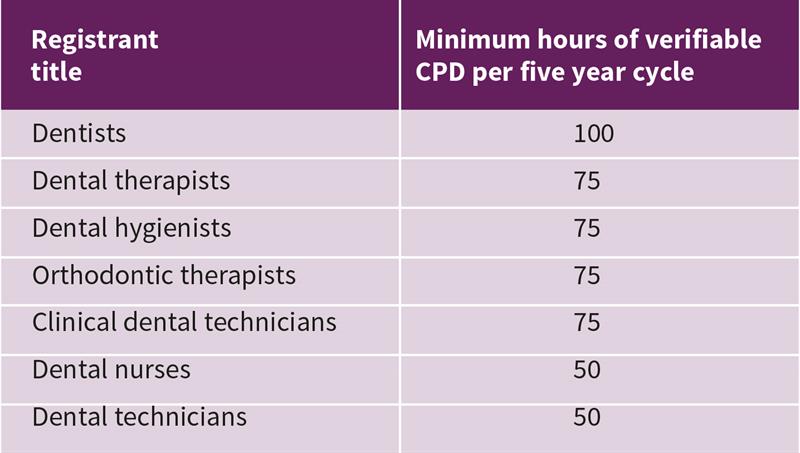
Table 1. Source GDC website.
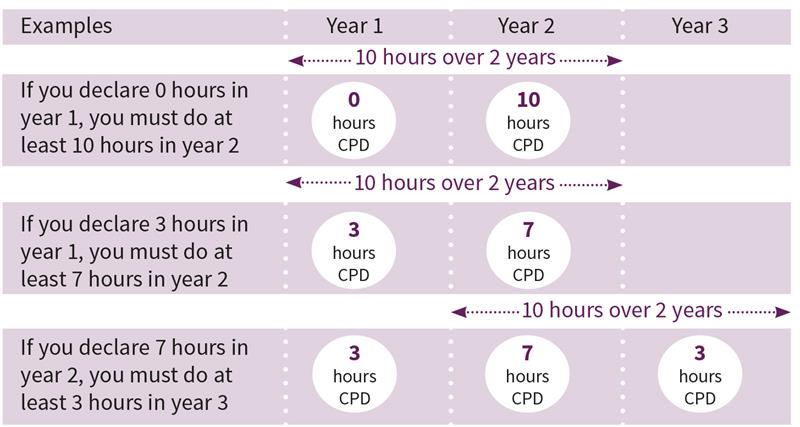
Table 2. Source GDC website.
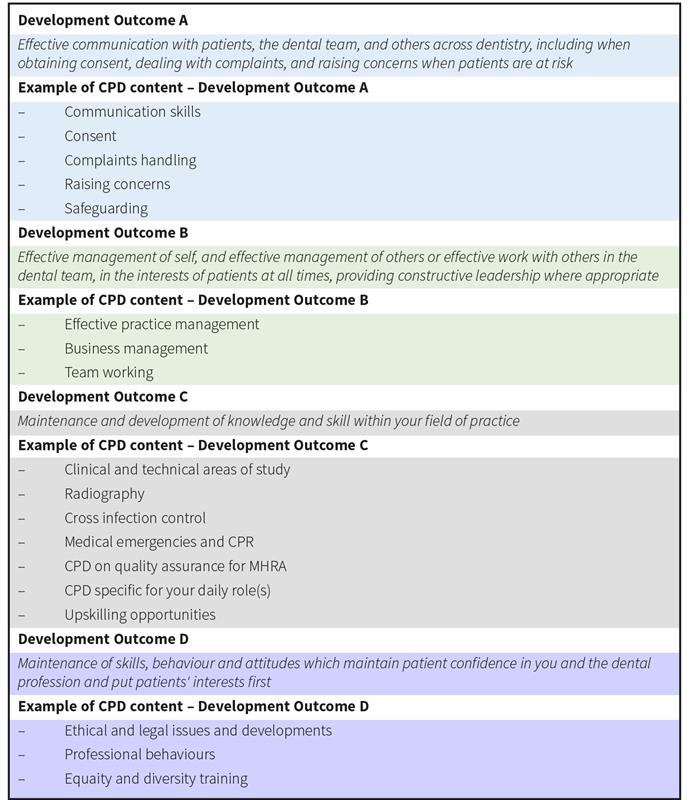
Table 3: Source GDC website.

Table 4. Field of practice example. Source GDC website.
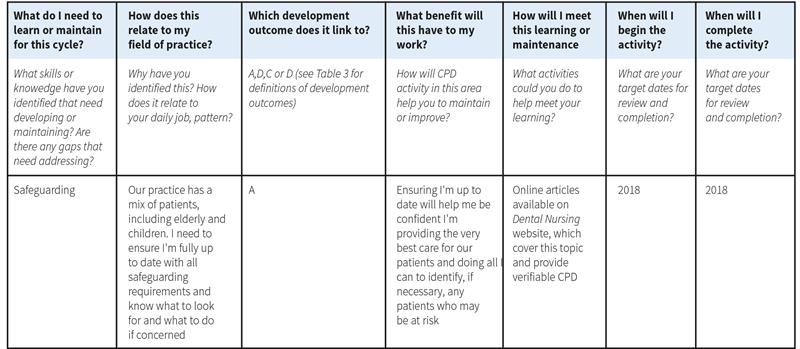
Table 5. My personal development plan example. Source GDC website.
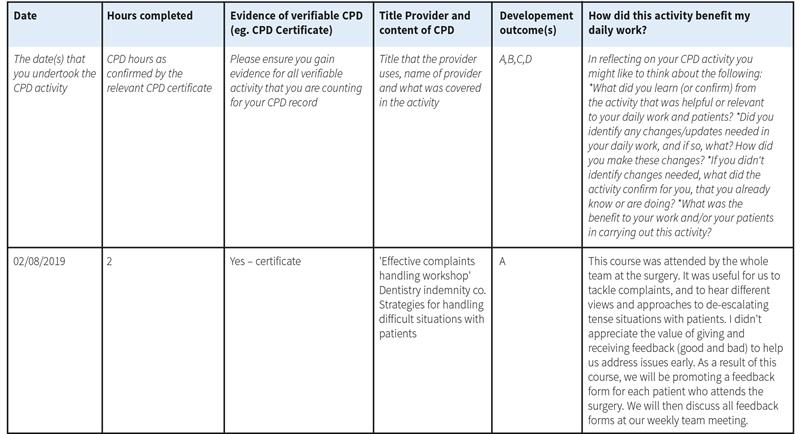
Table 6. CPD activity log example. Source GDC website.
Allocation of hours over your CPD cycle
You must ensure you complete at least 10 hours verifiable CPD for every two consecutive CPD years. You must not declare two consecutive years with nil CPD (10 hours CPD is the absolute minimum you must meet for any two consecutive years).
One year at zero is fine, provided you meet the 10 hours minimum over two consecutive years (Table 2).
Verifiable CPD and recommended topics
You need to ensure you select CPD activity that is verifiable and meets the provider requirements set out by the GDC.
Of course, you may choose to undertake non-verifiable CPD in addition to the verifiable required by the GDC. Non-verifiable CPD is no longer to be included in your report/submission to the GDC.
In order to meet the verifiable rule, providers should include the following information about CPD they are providing:
- The subject, learning content, aims and the objectives
- The anticipated GDC development outcomes of the CPD
- The date(s) the CPD was undertaken
- The total number of hours of CPD undertaken
- The name of the professional who participated in the CPD activity
- That the CPD is subject to quality assurance, with the name of the person or body providing the quality assurance
- Confirmation from the provider that the information contained is full and accurate
- It should also include your registration number.
Providers should also include a quality assurance/control statement, e.g. if you’re in doubt about whether an activity meets the criteria for verifiable CPD, ask the provider to give you written information on how it will meet the requirements and check this before you undertake the activity.
The GDC recommends you carry out a diverse range of activities that are best suited to your field of practice and individual needs, and not always in isolation.
Verifiable CPD may include the following:
- Courses and lectures
- Training days
- Hands-on clinical training or workshops
- Clinical audit
- Attending conferences
- eLearning activity.
Recommended topics (replaces core topics)
The GDC will continually review their recommended topics and advise you to check its website for any changes (https://www.gdc-uk.org/professionals/cpd/cpd-topics).
Note that topics are not compulsory and you must consider carefully what’s most relevant to your own field of practice.
As a dental professional, you must plan your CPD activity as it relates to your field of practice during your CPD cycle.
To help and support you in your CPD choices, the GDC has identified some CPD topics that will relate to many dental professionals in their field of practice. These are highly recommended to do as part of the minimum verifiable CPD requirement. These are:
- Medical emergencies: at least 10 hours in every CPD cycle – recommended that you do at least two hours of CPD in this every year
- Disinfection and decontamination: recommended that you do at least five hours in every CPD cycle
- Radiography and radiation protection: recommended that you do at least five hours in every CPD cycle. This applies only to those who undertake radiography.
The GDC also recommends that you keep up to date by doing CPD in the following areas:
- Legal and ethical issues
- Complaints handling
- Oral cancer: early detection
- Safeguarding children and young people
- Safeguarding vulnerable adults.
The GDC makes these recommendations because it believes regularly keeping up to date in these topics contributes to patient safety. Those not working in the clinical setting may wish to plan what is relevant and unique to them.
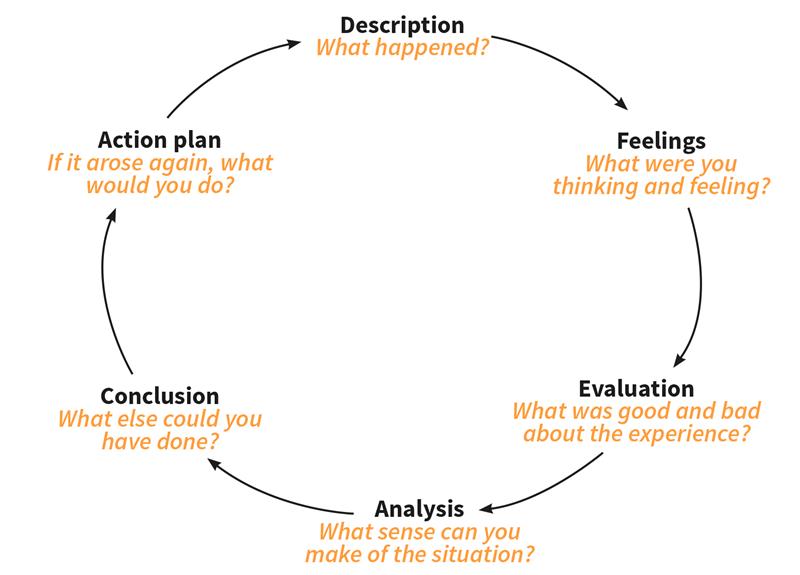
Table 7. Gibbs model of Reflection. (Source Rose & Best (2005)).
Development outcomes
There are four Development Outcomes (A-D), definitions in Table 3.
- You must make sure each planned and completed activity has at least one outcome (A, B, C, D) linked
- It is possible for some CPD activities to link to multiple outcomes
- The GDC encourages you to choose CPD to cover all four development outcomes in your cycle – however, this is not a compulsory requirement.
Keeping a record
Enhanced CPD focuses on following four steps: plan, do, reflect and record.
You must ensure you keep the following records:
- Field of practice record
- Personal Development Plan (PDP)
- CPD activity log
- Evidence (e.g. certificates)
- Reflection.
Definitions
Field of practice – Your role, your place of work and your patient make-up/type
PDP –The CPD you plan to do, how you plan to do it (who is providing the course/activity/article etc.) when you plan to do it and which Development Outcome it will fall in to (1 or more)
CPD activity log –What you did, when you did it and with whom (who provided the course/activity), what evidence you have of having taken it, and the development outcome/s.
You must also provide evidence of reflection on the CPD undertaken
Evidence – CPD certificates or any other form of evidence
Reflection – A way of thinking about your CPD activity with a focus on what you have learned. This may be on a periodic basis.
Field of practice record
Where you state your role, your place of work and your patient make-up/type
This consists of four headings:
- My registrant title(s) and cycle period
- My work settings
- Any additional roles, qualifications or professional interests
- My patient population.
1. My registrant title(s) cycle period, hours required:
List each title you are registered under, your cycle period and total hours needed.
2. My work setting(s): What is your place(s) of work and its environment?
Different settings may require you to undertake certain roles and skills.
3. Any additional roles, qualifications or professional interests:
Do you have additional roles, qualifications, specialties or areas of focus/interest? Do any of these need continual learning or maintenance?
4. My patient population:
What are the oral health and management needs of patients in your care? Does this change across your work settings?
• See Table 4.
Personal Development Plan
This is where you outline what CPD you plan to do, how this relates to your role and how you anticipate it being beneficial. You should include the anticipated development outcomes (learning outcomes), who is providing the course/activity/article etc, and when you plan to do it.
Your PDP includes the following:
- The CPD you plan to undertake during your cycle, which must include CPD that is relevant to your current or intended field(s) of practice
- The anticipated development outcomes that will link to each activity
- The timeframes within which you expect to complete your CPD over your cycle
- Date undertaken (start date/completion date)
- Description
- Aims and objectives
- Development outcomes (A-D)
- When you intend to reflect.
CPD activity log
The GDC requires you to review and reflect upon your CPD, to evaluate the impact of the activity, assess what you have gained and consider how you have implemented your learning.
Reflection is also encouraged so you can adjust your planned activity accordingly (if needs be) (see Table 5).
Your CPD activity log needs to include all verifiable CPD undertaken and this must include the following details:
- The title and description of the CPD activity you completed
- The date it was undertaken
- The number of hours, as shown on the evidence of completion (e.g. certificate) provided by the course provider (breaks and travel time do not count towards the number of hours of CPD)
- The GDC’s development outcome(s) achieved from each CPD activity
- Comments to illustrate the reflection and consideration on the CPD activity.
For any CPD to be considered verifiable, the activity must be recorded on your activity log, and you must have collected corresponding evidence (e.g. certificates).
If the GDC requests to see your CPD record, you are not required to include any information about any non-verifiable CPD completed in your cycle (see Table 6).
Evidence
You must obtain evidence of having completed the verifiable CPD activity. In most cases, the evidence will come in the form of a certificate (hard copy or electronic), although there may be exceptions to this. You must use your professional judgement to determine the evidence you need to demonstrate that the activity is verifiable.
Evidence must include the following:
- The subject, learning content, aims and objectives
- The anticipated GDC development outcomes of the CPD
- The date(s) the CPD was undertaken
- The total number of hours of CPD undertaken
- The name of the professional who participated in the COD activity
- That the CPD is subject to quality assurance, with the name of the person or body providing the quality assurance
- Confirmation from the provider that the information contained is full and accurate
- Your registration number.
Reflection
The GDC has framed reflection as a way of thinking about your CPD activity, focusing on what you have learned and the impact this learning can have on your practice. It recognises that reflection is an individual process and, as such, you can reflect in a way that is a best fit for you and the CPD activity.
It also makes clear that you can make a decision to reflect after each activity, periodically or at the end of the year and either as an individual or with other professional colleagues e.g. a mentor, peer or employer.
Remember how and when you intend to reflect must appear on your CPD log.
There are a number of reflective models to help you. One of the most commonly applied models is the Gibbs (1988) model (see Table 7) 2.
It may be that, when you first begin this journey, you wanted to adopt reflective practice for each CPD activity. However, as your confidence and skills improve with reflection, you may move to periodic reflection. Your reflection should inform your PDP and may lead to you rethinking your planned CPD activity.
References
- The GDC website includes documentation on all aspects of Enhanced CPD as well as templates, examples and a full set of rules. Links to the above can be found at https://www.gdc-uk.org/professionals/cpd/enhanced-...
- The Gibbs model of Reflection. Source Rose & Best (2005)
Help and support
The Society of British Dental Nurses offer help and support to registered dental nurses and those either returning to work or who are newly qualified. We offer a wider support service to our members including documentation guidance and a check list when planning cpd events, helping you to make ‘good cpd decisions’.
The Society are currently running roadshows – ‘The Myth Busting of Enhanced CPD’ if you would like us to runa session in your area contact us at admin@bdns.org.uk and we would be happy to discuss this with you.
Your professional portfolio should have:
- A contents page listing the sections of your portfolio and the relative page numbers
- A front page with your name, your GDC number, the start date of your CPD cycle and the end date of your CPD cycle as well as your registered title and your current role
- CPD flow chart supporting rationale for CPD decisions (optional)
- Diagram of transitional position if mid-cycle (optional)
- Personal development plan
- Log of your CPD activity
- The evidence of your CPD activity (certificates, etc)
- Reflection activity (and statement – optional)
- A grid showing CPD hours completed per year (optional)
- A grid showing GDC development outcomes addressed per year (optional)
- Record of changes in direction and and rationale for doing so (optional)
- End of year statement (optional for portfolio, but mandatory for GDC)
- End of cycle statement (optional for portfolio, but mandatory for GDC)
- Section designated to interruption of GDC registration (optional)
Author: Fiona Ellwood











.jpg?width=150&height=100&scale=canvas)

